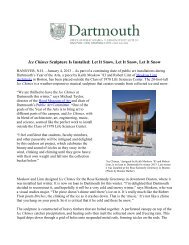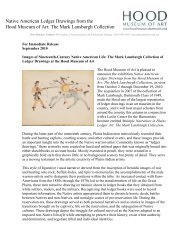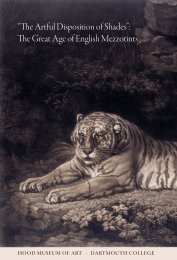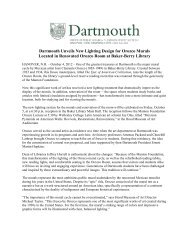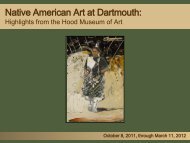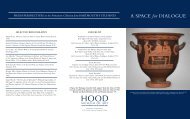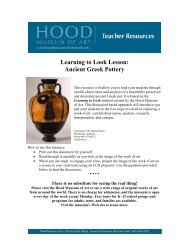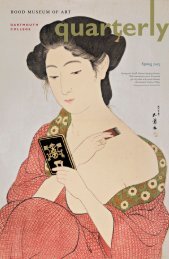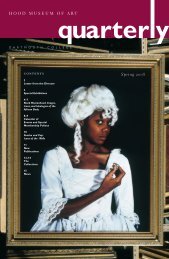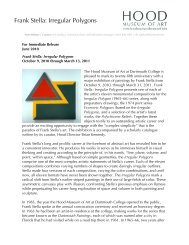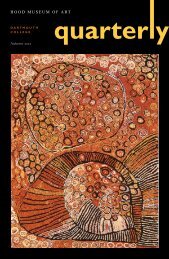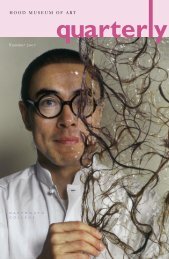Frank Stella - Hood Museum of Art - Dartmouth College
Frank Stella - Hood Museum of Art - Dartmouth College
Frank Stella - Hood Museum of Art - Dartmouth College
You also want an ePaper? Increase the reach of your titles
YUMPU automatically turns print PDFs into web optimized ePapers that Google loves.
Learning to Look Lesson:<br />
<strong>Frank</strong> <strong>Stella</strong><br />
This resource will allow you to lead your<br />
students through careful observation and<br />
analysis <strong>of</strong> a painting by <strong>Frank</strong> <strong>Stella</strong>. It is<br />
based on the Learning to Look method<br />
created by the <strong>Hood</strong> <strong>Museum</strong> <strong>of</strong> <strong>Art</strong>. This<br />
discussion-based approach will introduce you<br />
and your students to the five steps involved in<br />
exploring a work <strong>of</strong> art: careful observation,<br />
analysis, research, interpretation, and critique.<br />
<strong>Frank</strong> <strong>Stella</strong>, American, born 1936<br />
CHOCORUA IV<br />
Fluorescent alkyd and epoxy paints on canvas, 1966<br />
<strong>Hood</strong> <strong>Museum</strong> <strong>of</strong> <strong>Art</strong>, <strong>Dartmouth</strong> <strong>College</strong>; Purchased through the Miriam and Sidney Stoneman Acquisition Fund, a<br />
gift from Judson and Carol Bemis, Class <strong>of</strong> 1976, and gifts from the Lathrop Fellows, in honor <strong>of</strong> Brian Kennedy,<br />
Director <strong>of</strong> the <strong>Hood</strong> <strong>Museum</strong> <strong>of</strong> <strong>Art</strong>, 2005-2010.<br />
© 2010 <strong>Frank</strong> <strong>Stella</strong>/ <strong>Art</strong>ist Rights Society (ARS), New York. Photo by Steven Sloman<br />
How to use this resource:<br />
• Print out this document for yourself.<br />
• Read through it carefully as you look at the image <strong>of</strong> the work <strong>of</strong> art.<br />
• When you are ready to engage your class, project the image <strong>of</strong> the work <strong>of</strong> art on<br />
a screen in your classroom using an LCD projector. Use the questions provided<br />
below to lead the discussion.<br />
• • • •<br />
There is no substitute for seeing the real thing!<br />
Please visit the <strong>Hood</strong> <strong>Museum</strong> <strong>of</strong> <strong>Art</strong> to see a wide range <strong>of</strong> original works <strong>of</strong> art<br />
from around the world. There is no charge for admission, and the museum is open<br />
every day <strong>of</strong> the week except Monday. Free tours for K–12 school groups and<br />
programs for adults, teens, and families are available.<br />
Visit the museum's Web site to learn more.
Step 1. Close Observation<br />
Ask students to look carefully at this work <strong>of</strong> art and describe everything they see. Start<br />
with broad, open-ended questions like these:<br />
What do you notice when you look at this image<br />
What else do you see<br />
Become more and more specific as you guide your students’ eyes around the work with<br />
questions like these:<br />
What shapes do you see<br />
Describe them.<br />
Are the shapes hard-edged or s<strong>of</strong>t<br />
Is there any space between them<br />
How are the shapes arranged<br />
What colors do you see<br />
Are they bright dark dull shiny<br />
How would you describe this composition<br />
Is it symmetrical asymmetrical<br />
stable moving flat three-dimensional<br />
This work is made up <strong>of</strong> a single canvas. Trace your finger around the outer edge <strong>of</strong> the<br />
work. How is this painting different from other paintings you have seen<br />
Step 2. Preliminary Analysis<br />
Once your students have listed everything they noticed about this painting, begin asking<br />
simple analytical questions that will deepen your students’ understanding <strong>of</strong> the work.<br />
For instance:<br />
How are the shapes interacting in this work Are they layered over one another or are<br />
they pushing into one another Is there any movement here<br />
What effect do the colors have on the work Do some shapes recede while others<br />
project Is the overall effect flat or three-dimensional A little <strong>of</strong> both<br />
Do the shapes remind you <strong>of</strong> anything in nature<br />
What do you think this artist is interested in
After each response, always ask, “How do you know” or “How can you tell” so that<br />
students will look to the work for visual evidence to support their theories.<br />
Step 3. Research<br />
At the end <strong>of</strong> this document, you will find some background information on this painting.<br />
Read or paraphrase it for your students.<br />
Step 4. Interpretation<br />
Interpretation involves bringing your close observation, preliminary analysis, and any<br />
additional information you have gathered about an art object together to try to understand<br />
what a work <strong>of</strong> art means. There are <strong>of</strong>ten no absolute right or wrong answers when one<br />
is interpreting a work <strong>of</strong> art, but there are more thoughtful and better informed ones. It is<br />
important to challenge your students to defend their interpretations based upon their<br />
visual analysis and research.<br />
Some basic interpretation questions for this painting might include the following:<br />
Compare Chocorua IV with Chocorua I, II, and III. (Images <strong>of</strong> the other three<br />
paintings in this series are included at the end <strong>of</strong> this resource.) What effect does<br />
changing the color have on these works Why do you think <strong>Frank</strong> <strong>Stella</strong> wanted to<br />
work in series<br />
How are these paintings like traditional paintings How are they different<br />
How are they like sculpture How are they different<br />
<strong>Stella</strong> was deeply interested in abstraction (an art that is not consciously<br />
representational but rather made up <strong>of</strong> lines, shapes, and colors) and removing<br />
any illusion <strong>of</strong> three-dimensionality in his painting.<br />
Are these paintings purely abstract Why or why not<br />
Are they fully flat or are they still somewhat three-dimensional Why<br />
What new ideas do you think <strong>Frank</strong> <strong>Stella</strong>’s irregular polygons contributed to the<br />
world <strong>of</strong> art
5. Critical Assessment and Response<br />
Critical assessment and response involves a judgment about the success <strong>of</strong> a work <strong>of</strong> art.<br />
It is optional but should always follow the first four stages <strong>of</strong> the Learning to Look<br />
method. <strong>Art</strong> critics <strong>of</strong>ten engage in this further analysis and support their opinions based<br />
on careful study <strong>of</strong> and research about a work <strong>of</strong> art.<br />
Critical assessment involves questions <strong>of</strong> value. For instance:<br />
Do you think this irregular polygon painting is successful and well done Why or why<br />
not<br />
This fifth stage can also encompass one’s response to a work <strong>of</strong> art.<br />
Do you like these works <strong>of</strong> art Do they move you<br />
Are the ideas <strong>Frank</strong> <strong>Stella</strong> was exploring in these paintings still relevant today<br />
One’s response can be much more personal and subjective than one’s assessment.
BACKGROUND INFORMATION<br />
<strong>Frank</strong> <strong>Stella</strong>, American, born 1936<br />
Chocorua IV<br />
Fluorescent alkyd and epoxy paints on canvas<br />
1966<br />
<strong>Hood</strong> <strong>Museum</strong> <strong>of</strong> <strong>Art</strong>, <strong>Dartmouth</strong> <strong>College</strong>; Purchased through the Miriam and Sidney Stoneman Acquisition Fund, a<br />
gift from Judson and Carol Bemis, Class <strong>of</strong> 1976, and gifts from the Lathrop Fellows, in honor <strong>of</strong> Brian Kennedy,<br />
Director <strong>of</strong> the <strong>Hood</strong> <strong>Museum</strong> <strong>of</strong> <strong>Art</strong>, 2005-2010. © 2010 <strong>Frank</strong> <strong>Stella</strong>/ <strong>Art</strong>ist Rights Society (ARS), New York<br />
Photo by Steven Sloman<br />
<strong>Frank</strong> <strong>Stella</strong> has had a long and prolific career at the forefront <strong>of</strong> abstract<br />
art. A consistent innovator who prefers to produce works in series, he has<br />
immersed himself in visual thinking and creating, according to certain key<br />
artistic principles: “Line, plane, volume and point, within space.”<br />
The Irregular Polygons series <strong>of</strong> 1965–66 is startlingly dramatic<br />
and original. (A polygon is a flat shape bounded by straight lines. An irregular polygon is<br />
made up <strong>of</strong> uneven sides and angles.) Although based on simple geometries, these<br />
paintings comprise one <strong>of</strong> the most complex artistic statements <strong>of</strong> <strong>Stella</strong>’s career.<br />
The artist created eleven compositions, combining varying numbers <strong>of</strong> shapes to create<br />
daringly irregular outlines. There are four versions <strong>of</strong> each composition, each with a<br />
different color combination. The Irregular Polygons marked a radical shift from <strong>Stella</strong>’s<br />
earlier striped paintings in their use <strong>of</strong> large fields <strong>of</strong> color. These asymmetric canvases<br />
play with illusion and explore space and volume in both painting and sculpture.<br />
Chocorua is perhaps the most direct <strong>of</strong> <strong>Stella</strong>’s irregular polygon compositions.<br />
He observes: “Some things are more immediately successful;<br />
some things work better than others.” The central themes <strong>of</strong> Chocorua is the<br />
interpenetration <strong>of</strong> an equilateral triangle and a square, and the interlocking or abutting <strong>of</strong><br />
shapes. The illusion <strong>of</strong> depth is caused mainly by the different values <strong>of</strong> the colors,<br />
because although the shapes abut or impinge upon each other, they do not overlap. The<br />
Irregular Polygons are two-dimensional, but as <strong>Stella</strong> explains: “There’s a very shallow<br />
type <strong>of</strong> illusion going on in Chocorua. . . once you’re committed to doing this in three<br />
dimensions, then it really would be a pyramid inside a cube.” The lightning-like band that<br />
cushions the triangle reinforces the larger area’s ability to contain the triangle, rather than<br />
make the area appear to be seeking to eject it.<br />
<strong>Stella</strong> associates the triangle in Chocorua with “the big mountain”—Mount Chocorua in<br />
the White Mountains <strong>of</strong> New Hampshire. When he began working on the Irregular<br />
Polygons, he found that “they were so immediately landscape and mountainous” that he<br />
decided to name them after places he had visited with his father during his boyhood. This<br />
implies that <strong>Stella</strong>’s painting titles are not always as arbitrary as he has <strong>of</strong>ten claimed but<br />
instead have personal associations with people, landscapes, and places he has visited.
Chocorua I<br />
Chocorua I, 1965-1966, fluorescent alkyd and epoxy paints on canvas<br />
Los Angeles County <strong>Museum</strong> <strong>of</strong> <strong>Art</strong>, Los Angeles, U.S.A.<br />
Gift <strong>of</strong> the artist through the Contemporary <strong>Art</strong> Council, 1966; M.66.90 Digital Image ©2009 <strong>Museum</strong><br />
Associates/LACMA/<strong>Art</strong> Resource, NY.<br />
© 2010 <strong>Frank</strong> <strong>Stella</strong>/<strong>Art</strong>ists Rights Society (ARS), New York
Chocorua II<br />
Chocorua II, 1966, fluorescent alkyd and epoxy paints on canvas<br />
The Speed <strong>Art</strong> <strong>Museum</strong>, Louisville, KY: <strong>Museum</strong> Members Purchase; 1967.44.<br />
© 2010 <strong>Frank</strong> <strong>Stella</strong>/<strong>Art</strong>ists Rights Society (ARS), New York
Chocorua III<br />
Chocorua III, 1966, fluorescent alkyd and epoxy paints on canvas<br />
Milwaukee <strong>Art</strong> <strong>Museum</strong>, Gift <strong>of</strong> Friends <strong>of</strong> <strong>Art</strong>; M1968:12.<br />
© 2010 <strong>Frank</strong> <strong>Stella</strong>/<strong>Art</strong>ists Rights Society (ARS), New York



